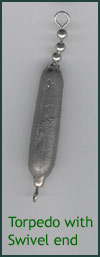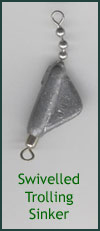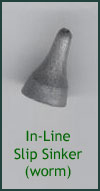Weights and Sinkers
Like hooks, there are many different kinds
but for the beginner, we recommend the split
shot, which are inexpensive, easy to use
and versatile. Purchase several sizes of
removable split shot and squeeze them on
with your pliers. Most sinkers have traditionally
been made of lead, however, more environmentally
friendly alternatives, such as bismuth and
tin, are slowly becoming available.
Let's start by saying, "Use only as much weight as you possibly have to. Less is more!" If you take anything away from reading this section on weights, please remember this: use as little weight as you possibly can.
When you weigh down your tackle you are discouraging fish from striking, in most cases, especially the kinds of fish that have less than explosive strikes. The resistance that weights give line and lures, both artificial and natural, can in many cases be enough to turn fish away.
In addition, it will dull the sensations that you, the angler, will sense and as a result you are likely to miss strikes that you normally would have been prepared for. Even if you do feel the strike, setting the hook becomes a more difficult task with additional weight, since the pull of the hook set will, in many cases be absorbed by the heavily weighted line.
Less is more.
Considerations
There are many things to consider regarding weights depending on the type of fishing that you are doing, the kind of tackle that you have, etc. For freshwater anglers, heavy weight usage usually translates into a less involved fishing experience. You require much heavier tackle, which can be additional work, more tiring and less sporting or fun in the traditional sense, compared to finesse fishing.
Smaller fish don't provide the same experience on heavy tackle as they do on light gear. There are negatives to using heavy weight on larger game fish as well. Again, depending on the type of fishing you are doing and the weight you are using, larger fish can also tire more easily. Feedback that we have received has suggested that more fish are lost with excessive weight usage due to improper setting of the hook. There is more to this than simply the amount of weight that is added and the physical effects that they have. Which brings us to the question of design.
Weights and sinkers are not just hunks of metal. Over the years much thought has gone into the shape and design of them. We can't list every design and combination of weight, snap, swivel, etc., on this site, however, if you have a specific question regarding specific weights, please let us know with an email to ask@fishresource.com and we will be happy to research it for you.
By choosing the correct design for the type of fishing that you will be doing, you will be able to accomplish the desired results with less weight. Remember, less is more. The wrong design will likely cause you to be using more weight than required and affect your angling and ability to put fish on the end of your line. What is the right design? Let's consider what we are looking to achieve with the additional weight we attach first and understand what the different functions and styles of weights we have to choose from.
If we were to define weight, a standard dictionary would tell us that it is the force that gravity exerts on a body equal to it's mass times the acceleration of gravity. In essence, weight is a matter of density - anything that is more dense than water can be used as a fishing weight - some things being better than others of course. In a pinch, you can rig almost anything to act as a weight if you have to - old nuts and bolts are common enough items on boats. If you dig deep into your memories, we're sure you can conjure up some makeshift weight arrangement from your younger years. The crew at Fishresource.com collectively has well over a century of fishing experience, and we can all remember forcing something to become a weight on the end of our line at one point or other. If you're like us, you'd rather be fishing than not.
Functions of the Weight and Sinker
 What do weights and sinkers do? A simple enough question, right? They do many different things for many different anglers and they come with many different features and functions. These features, such as swivels, locks, etc., can be an asset to the angler or a liability depending on how they are used. The extreme variety of weights and sinkers on the market complicates matters even more. On the positive side, making sense of all this, the vast variety gives the informed angler a greater choice to pick the right tackle for the right job. What do weights and sinkers do? A simple enough question, right? They do many different things for many different anglers and they come with many different features and functions. These features, such as swivels, locks, etc., can be an asset to the angler or a liability depending on how they are used. The extreme variety of weights and sinkers on the market complicates matters even more. On the positive side, making sense of all this, the vast variety gives the informed angler a greater choice to pick the right tackle for the right job.
We use weights to do many things, primarily to help cast, drift, anchor, sink and troll and present all kinds of baits and lures, so understanding the objectives is crucial to ensuring that you pick the right weight for the job at hand.
Casting: Weights play one of their most important roles in casting, and when casting with weights, there are a number of considerations to keep in mind. First and foremost, you should ensure that the weight of the sinker that you are using is within the recommended casting-weight range of the rod, as well as the line that you are using.
Another consideration regarding line that you should be aware of is that you make sure the line is also within balance with the weight and the sinker. The weights that will cast the farthest and most accurately are the streamlined, bell shaped, bottom-heavy ones. It is with weights, like with everything else - the less forces acting upon it, such as air resistance and line drag, the farther and more accurate the flight.
With as many types of weights and sinkers available on the market today, we suggest that unless you have special requirements, the best weights to go with are the bell-shaped or the tear drop shaped (picture above) which is great for accurate casting, etc. The thinner, almost spoon-like weights can be challenging in that they tend to shoot off course very easily.
 Another thing to keep in mind is that basically all the same forces and drags that act upon the lure in the air will also act upon it in the water as well. It is a matter of fluid (hydrodynamics) and air (aerodynamics) that will be acting upon it. Additionally, if casting near structure, you may also run into situations where you will encounter a wide variety of obstacles, such as logs, weed beds, pilings and rocks. Casting accuracy is important. Inches can mean the difference between success and failure and the loss of a lucky lure. Another thing to keep in mind is that basically all the same forces and drags that act upon the lure in the air will also act upon it in the water as well. It is a matter of fluid (hydrodynamics) and air (aerodynamics) that will be acting upon it. Additionally, if casting near structure, you may also run into situations where you will encounter a wide variety of obstacles, such as logs, weed beds, pilings and rocks. Casting accuracy is important. Inches can mean the difference between success and failure and the loss of a lucky lure.
Anchoring: Weights that cast well may or may not be such good choices when it comes to anchoring. In still waters you are likely to have no worries. In waters with significant current, there are different considerations that apply. Not only will there be drag on the submerged line, but you must also consider the steady pounding of surface waves, that will constantly push and pull at the line.
With anchoring, everything starts when the weight or sinker hits the bottom. Whether the bottom is hard or soft, sandy or muddy, rocky or smooth are all considerations that should be thought of. On softer, cleaner bottoms, a sinker that will "attach" itself is a better choice. These sinkers stand a better chance of holding in place under different conditions and forces that act upon it, such as current, etc.
The teardrop sinker that we recommend so much is not always a good choice when anchoring is required. They tend to roll, drag, and are easily influenced by the water conditions, so when considering anchoring as a technique, we would recommend nor angular or complex shapes to assist in holding fast. Flat sinkers, on the other hand, are likely to embed or bury themselves in softer bottom compositions which is desirable. For serious anchoring, hooked, spurred or angular sinkers will find their way into the bottom for a solid hold.
 Sinking: The sinking of your weight in the air and then the water, is simply gravity acting upon it in the way it does with everything else. For the angler, when it comes to weights and sinkers, gravity is working for you and not against you, as is the case with casting. Sinking: The sinking of your weight in the air and then the water, is simply gravity acting upon it in the way it does with everything else. For the angler, when it comes to weights and sinkers, gravity is working for you and not against you, as is the case with casting.
As with casting, there are a few considerations to think about when it comes to accuracy. You may be able to cast exactly where you want, however, you must also consider the strength and speed of the current, and how it will affect the sinker, once underwater. Under surface currents can easily drift a sinker away from it's intended bottom target.
Having said that, how can you affect this? Consider this: the faster a weight sinks, the less time currents, etc., have to affect it. You can increase the rate at which your sinker descends by simply increasing the weight. If increasing weight is not a good option for the type of fishing you are doing, you can always increase the rate at which your sinker descends by using a more streamlined or aerodynamic weight to decrease resistance and speed the sinker to the bottom.
Drifting & Dragging: When discussing weights in this capacity, we are talking about how we move baits or lures across the bottom, although not necessarily on the bottom, and this can be as a result of the careful retrieve of the angler, or simply the drift action of a boat or current.
The most important characteristic of weights and sinkers used for these purposes is that they do not snag or catch hold very easily, which is why we generally recommend, again, bottom heavy weights. Cylindrical weights are also good, as well as flat, almost spoon shaped sinkers, as long at the line is connected to the top, increasing the chances of a "top pull" to lift the weight free, when snagged.
 The bottom composition makes a difference when considering what to use. If you are dealing with a smooth bottom, you have less to worry about and consider, and for practical purposes, you can choose from a larger variety, since there is less risk of snagging. For rough and broken bottom, we recommend that you play it safe with the above suggested weights and sinkers, to give you more time fishing and less time trying to recover your line. The bottom composition makes a difference when considering what to use. If you are dealing with a smooth bottom, you have less to worry about and consider, and for practical purposes, you can choose from a larger variety, since there is less risk of snagging. For rough and broken bottom, we recommend that you play it safe with the above suggested weights and sinkers, to give you more time fishing and less time trying to recover your line.
The crew at Fishresource.com has had success using the bell-shaped weights when dragging, especially when fishing for catfish. We have had a lot of success using pork rinds dragged along the bottom behind the drift sinkers. Give it a try and let us know what happens.
Trolling: Bottom trolling, as opposed to surface trolling, requires a different type of sinker all together. For purposes of this discussion, we will limit ourselves to bottom trolling, or below surface trolling, with smaller hand held rigs, versus larger commercial trolling equipment and heavy tackle.
Trolling sinkers include the torpedo, which offers the angler an option of minimal drag and resistance. The bead chain styles with fins are also excellent choices, since they offer the angler minimal line twist. Numerous styles of trolling weights are available.
As a general rule, the bait or lure presented should be held held at the desired depth, and secondly the sinker, and or rig, should never twist the line or exert any significant force or action on the bait or lure. Good trolling sinkers are designed, through the use of fins, shape, etc., to dive deeper than their own weight would effect. They are also stabilized in some way (with a fin, for example) to prevent any kind of wobbling action or unwanted twisting of the line.
The best designed trolling weights have been designed to ensure that the bulk of the weight hangs below the line, and these often resemble various shapes such as fins or wings. What this translates to is that the weight is considered to be down-weighted and as such will stay balanced so as not to twist or swivel the line. Many of these will come with swivels attached - see the picture of the swiveled trolling sinker above. |